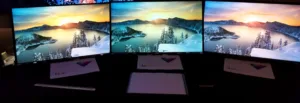PixelDisplay is a company that debuted at last year’s SID conference with a method to create narrow band RGB light for wide color gamut HDR displays. They showed a demo of an LED with the special VividColor materials that was said to have achieved 97.8% of the BT.2020 color gamut. Such very wide color gamut displays remain of interest, said PixelDisplay CTO David Wyatt at CES 2018, but the company is now more focused on solving wide color challenges in the mobile and PC monitor segments. (although Ken wasn’t impressed PixelDisplay: Old Wine in a New Bottle)
In the SID demo, PixelDisplay showed a solid state LED light source with RGB primaries at 467, 532 and 630 nm and Full Width Half Maximum (FWHM) values of 10nm for each primary. This produces 97.8% coverage of BT.2020. But for the TV market, the goal is simply DCI-P3 – there is no big push to achieve 2020 as there is no content mastered to this gamut, yet (even though they are in a container with 2020 coefficients).
Wyatt explained that for the mobile market where HDR is being implemented, there is a tradeoff between wider color gamut and light efficiency (and battery life). For a 10” WQXGA resolution HDR tablet, the panel backlight can consume 67% of the power budget. If a 20% improvement in the backlight efficiency can be achieved, that can lead to an increase of 1 hour in battery life or a 15% reduction in battery size and cost.
As a result, Wyatt proposes a new formulation of materials that will widen the spectral width of the RGB primaries leading to better efficiency with an increase in perceptual brightness. The Mobile HDR Premium specification from the UHD Alliance requires the device to achieve >90% of the DCI-P3 color gamut. Smartphones and tablets much achieve 540 cd/m² and laptop have to get to 600 cd/m².
Wyatt says quantum dots can meet this need but they are too expensive and the QD sheets are too thick. Nichia’s high gamut LED, which use a blue LED plus SiAlON and KSF phosphors, can achieve 96% of the P3 color gamut. However, Wyatt points out that KFS has a slow relaxation time, which means it will continue to glow red in 1D and 2D zone-based backlight designs. The zones can be modulated quite rapidly in response to the content, which can lead to red shifts.
Consequently, PixelDisplay has proposed two new formulations. VividColor 72R UHD work with the color filter 72 design and offers 98% coverage of P3. This design uses 450, 540 and 625nm as the primaries with FWHM values of 20, 50 and 50 nm. Wyatt stressed that these are phosphors that do not have long quenching times, so can be used in 1D and 2D zone backlight designs with no color shifts.
The second design lowers the color gamut coverage to 92% of P3 but allows for an increase in brightness of 2.3 to 1.5X. This is called Vivid Color 65R mUHD.
![]()
In its hotel suite at CES 2018, Wyatt demonstrated the 65R mUHD formulation and compared it to a traditional white LED using a YAG phosphor (79.9% of P3) and a quantum dot-based display (94.9% of P3). Wyatt noted that there was a loss of yellow with the white YAG but the Vivid Color display was close to the QD one. It was claimed to deliver this performance with either less power or more luminance, but Wyatt did not disclose these values for comparison.
Wyatt then turned to how their materials can be used for color conversion in microLED applications. Their materials can be used in either mass transfer or monolithic fabrication methods. In both cases, the base layer is blue/UV LEDs. If close packed, then a monolithic approach is best, or if pixels are more separated in space, then a mass transfer approach is used. Above each is a RGB patterned layer that matches the pitch of the underlying blue/UV emitters. The company is apparently working on methods to do this by direct depositing on the die, wafer deposition or a roll-to-roll process.
Wyatt also envisions using their materials to create a Vivid Color backlight using an array of blue LEDs covered with a conversion layer. This would eliminate the light guide plate allowing a FALD design, with color gamut coverage of the customer’s choosing.
Just to be sure he explained all the possibilities, Wyatt noted that they could even aim for a six primary display solution with coverage that was 120% of BT.2020.
![]()

